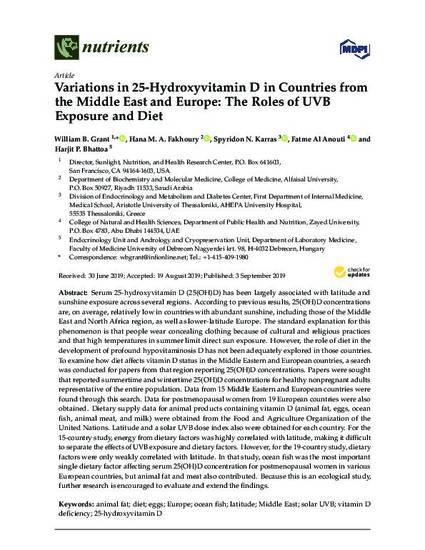
© 2019 by the authors. Licensee MDPI, Basel, Switzerland. Serum 25-hydroxyvitamin D (25(OH)D) has been largely associated with latitude and sunshine exposure across several regions. According to previous results, 25(OH)D concentrations are, on average, relatively low in countries with abundant sunshine, including those of the Middle East and North Africa region, as well as lower-latitude Europe. The standard explanation for this phenomenon is that people wear concealing clothing because of cultural and religious practices and that high temperatures in summer limit direct sun exposure. However, the role of diet in the development of profound hypovitaminosis D has not been adequately explored in those countries. To examine how diet affects vitamin D status in the Middle Eastern and European countries, a search was conducted for papers from that region reporting 25(OH)D concentrations. Papers were sought that reported summertime and wintertime 25(OH)D concentrations for healthy nonpregnant adults representative of the entire population. Data from 15 Middle Eastern and European countries were found through this search. Data for postmenopausal women from 19 European countries were also obtained. Dietary supply data for animal products containing vitamin D (animal fat, eggs, ocean fish, animal meat, and milk) were obtained from the Food and Agriculture Organization of the United Nations. Latitude and a solar UVB dose index also were obtained for each country. For the 15-country study, energy from dietary factors was highly correlated with latitude, making it difficult to separate the effects of UVB exposure and dietary factors. However, for the 19-country study, dietary factors were only weakly correlated with latitude. In that study, ocean fish was the most important single dietary factor affecting serum 25(OH)D concentration for postmenopausal women in various European countries, but animal fat and meat also contributed. Because this is an ecological study, further research is encouraged to evaluate and extend the findings.
- 25-hydroxyvitamin D,
- Animal fat,
- Diet,
- Eggs,
- Europe,
- Latitude,
- Middle East,
- Ocean fish,
- Solar UVB,
- Vitamin D deficiency
Available at: http://works.bepress.com/fatme-alanouti/7/
